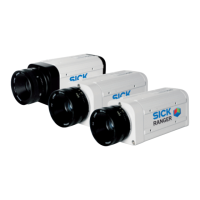Chapter 2 Reference Manual
Ranger E/D
18 ©SICK AG • Advanced Industrial Sensors • www.sick.com • All rights reserved
Overview
2.5 Triggering
There are two different ways in which external signals can be used for triggering the Ran-
ger to make measurements:
Enable Triggers the Ranger to start making a series of scans. When the
Enable signal goes high, the Ranger will start measuring a specified
number of scans. If the signal is low after that, the Ranger will pause
and wait for the Enable signal to go high again; otherwise it will con-
tinue making another series of scans.
The Enable signal could for example come from a photoelectric switch
located along the conveyor belt. It is also useful for synchronizing two
or more Rangers.
Pulse triggering Triggers the Ranger to make one scan. This signal could for example
come from an encoder on the conveyor belt. The Ranger C can also be
triggered by the CC1 signal on the CameraLink interface.
Figure 2.12 – Triggering the Ranger with Enable and Pulse triggering signals.
If pulse triggering is not used, the Ranger will measure in free-running mode – that is,
make measurements with a regular time interval determined by the Ranger’s cycle time.
The actual distance on the object between two profiles is then determined by the speed of
the object – that is, how far the object has moved during that time.
When measuring the true shape of an object, you should always use an encoder with the
Ranger. With the signals from the encoder as pulse triggering signals, it is guaranteed that
the distance that the object has moved between two profiles is well known.
You can find the actual distance between two profiles even if the Ranger is measuring in
free-running mode, as long as you have an encoder connected to the Ranger. The encoder
information can then be embedded with the profiles sent to the PC as mark data. Your
application can then use this information to calculate the distance between the profiles.
Enable
Profiles
Pulse
triggering
Number of scans
(Scan height)

